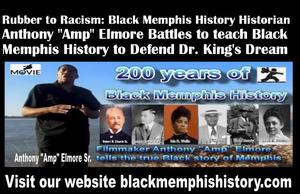Rubber to Racism: Black Memphis History Historian Anthony "Amp" Elmore Battles to teach Black Memphis History to Defend Dr. King's DreamOctober 07, 2025 at 03:00 AM EDT
 From Firestone's toxic legacy to Memphis Federal Troop incursion, Memphis activists expose Southern Tradition and Black complicity in the fight to protect New Chicago and honor Dr. King's dream of justice, dignity, and Black agency MEMPHIS, TN, October 07, 2025 /24-7PressRelease/ -- Memphis. Tennessee is back in the national spotlight reminiscence of 1968. Memphis, Tennessee the City where Dr. Martin Luther King Jr. was killed April 4, 1968. Memphis has a "Troubled history." While it is known that Memphis became "The Cotton Capital of the World" unknown and untold is the fact that Memphis also became the "Slave Capital of the world." By 1850 Memphis was the world's largest inland market for enslaved Black workers in the world. Memphis shows predominantly how Dr. King died and not how Dr. Martin Luther King Jr. lived. Black Memphis history is so troubling that it is obscured and not talked about in Memphis. Most do not know about the Memphis massacre of 1866. Click here to see and hear the pushback of of the Memphis City Council objecting to Federal Troops being sent be Memphis. On Monday September 29, 2025 in what is described as a major crackdown on violent crime a multi-agency operation, dubbed the "Memphis Safe Task Force," is unfolding in phases over the "next weeks and months," with federal law enforcement working alongside the Memphis Police Department and the Shelby County Sheriff's Office. This story is the absolute best diverse story in America regarding the current incursion of Federal Troops in Memphis. This story can be best explained as the best and most comprehensive documentary regarding Federal Troop in Memphis whereas this story is digital, historical, educational, entertaining, enlightening and utmost told via a 21st century paradigm. While this story is the best diverse story regarding Federal Troop in Memphis, 2025 marks the beginning of the culture of the erasure of DEI or Diversity, Equity and Inclusion. While "Diversity" is on the chopping blocks in America; entertainment, culture and history tells us many unknown and untold stories in Memphis. In 1969 one year after the death of Dr. Martin Luther King Jr. in Memphis "The King of the Blues" the late B.B. King released a song titled "Why I sing the Blues." African/Americans who experienced Jim Crow laws or those who has studied and read about the injustices in America relate to the "Memphis Safe Task Force" as an echo of injustice and a throwback of the 1960's in America where African/Americans were fighting for justice. Click here to see B.B. King perform the song in 1974 on the "Midnight Special." The NBC Midnight Special was kind of a mirror into the cultural vibe of the era of the early 1970's. The show brought all genres of live music to homes in America. Soul to Soul was three-night music festival in Kinshasa, Zaire (now the Democratic Republic of Congo) from September 22–24, 1974. Conceived by Hugh Masekela and Stewart Levine, the event was designed to coincide with the "Rumble in the Jungle" boxing match between Muhammad Ali and George Foreman. It featured renowned American soul artists like James Brown, B.B. King, and Bill Withers, performing alongside top African musicians, celebrating a pan-African cultural and musical event Click here to hear B.B. King perform the song in Kinshasa Zaire. Via the song Lyrics of the B.B. King sing "Why I sing the Blues" introduce readers to a course in Black history and Black Music history. There are Black music sounds and songs performed that words simply cannot explain and everyone can understand. When explaining the pain and hardship many Black Memphians feel regarding Federal Troops being sent to Memphis that cannot explained in words. The B.B. king Song "Why I sing the Blues Tells A Black Story via culture that many Whites simply may not understand. Music is a language. In todays word many Whites honor and respect the Blues traditions. One explanation regarding Black music that White grasped the language more than Blacks and that is the story of Black Guitarist Jimmy Hendricks whereas he spoke a language with his guitar that revolutionized White Youth in America. Also many Black Blues artist helped to revolutionize and created the "British Invasion" that created a "cultural shift in America." The Memphis Safe Task Force Represents a new cultural Shift in America. "Why I Sing the Blues" isn't just a song—it's a cultural syllabus, a sonic archive, and a spiritual reckoning. It compresses centuries of Black struggle, resilience, and artistry into a few verses and guitar licks that speak louder than any textbooks ever could. There is a verse in the Lyrics that says: I've laid in a ghetto flat Cold and numb, I heard the rats tell the bedbugs, To give the roaches some, Everybody wanna know, Why I'm singing the blues Yes, I've been around a long time People, I've paid my dues. Click here to see video titled: Fred G. Sanford vs. Federal Troops: A Sitcom's Truth in America's Courtroom. In the 1974 episode "Fred G. Sanford, Legal Eagle" from Sanford and Son, Fred G. Sanford walks into a courtroom filled with Black defendants and delivers a line that still echoes today: "There's enough Nig… in here to make a Tarzan movie." Though the language is jarring, the message is unmistakable—Fred G. Sanford was calling out the racial imbalance in America's justice system. His words, delivered in a sitcom, cut deeper than any political speech or policy paper. They exposed a reality that persists: Black Americans are disproportionately targeted, arrested, and incarcerated. African/Americans are only 12% of America's population but represent 40% of America's jails which are filled disproportionally with African/Americans. Blacks say; "In America Justice in America for Just Us." Please click here to read our in-depth story titled: Memphis fighting for King's Dream against Federal Troops. The sending of Federal Troops, Tennessee State Troopers to Memphis can be perceived by many as a way to "Make America Great Again." Southern Tradition notes; in sending Federal Troops to Memphis makes Memphis the model and "Whipping boy" whereas Southern traditions can celebrate Memphis as the City not only where Dr. Martin Luther King Jr. was killed, but Memphis has a History of "King Cotton." In fact there exists in Memphis " The Cotton Museum." Click here to view the 25 minute You Tube Video titled: Rubber to Racism Memphis Battle Federal Troops to Defend Kings Dream The sending of Federal troops to Memphis is a Whipping Boy symbol of Federal control, fear and a model for Southern Tradition. While the issue for Black Memphis is greater than more Federal investment, the issue for Black Memphis is its missing Black Memphis history education. The current culture in America has embolden "Southern Traditions". Click Here to see Video: On September 24, 2025 a group of uninvited Southern Traditional supporters called: "MAGA DEBATE GROUP" showed up at The Black Tennessee State University Campus to promote Southern traditional ideas and to debate for the eradication of DEI at the traditional Black Institution. The deployment of National Guard troops to Memphis echoes a troubling historical lineage that traces back to America's 7th President Andrew Jackson. Andrew Jackson is widely regarded as the architect of ethnic cleansing. His Indian Removal Act of 1830 forcibly displaced tens of thousands of Native Americans, whereas its unknown and untold that many native Americans were Black. Many Native Americans were Black and not brought directly from Africa. Click here to see the video education and learn more from Dr. Clyde Winters book and lectures "We Are Not Just Africans" see the video to learn about "Black Native Americans." Many Native Black Indians were also forcibly removed from their ancestral lands in America, culminating in the Trail of Tears—a brutal march that claimed thousands of lives. The founding of Memphis itself, on May 22, 1819, was orchestrated by Andrew Jackson alongside John Overton and James Winchester, following the coerced cession of Chickasaw land—a foundational act of dispossession that set the tone for Memphis's racialized geography. There is no comparison to Memphis Tennessee in regards to Southern Traditions. After the civil war Memphis became "The Capital of the South" whereas Jefferson Davis and Nathan Bedford Forrest moved to Memphis after the civil war. Memphis was "The Cotton Capital of the World." The once wealthiest man in Tennessee was Nathan Bedford Forrest who made his wealth as a Memphis Slave trader. He built a Slave jail in Memphis right by a Church and court house in downtown Memphis. During the Civil war Nathan Bedford Forrest became the hero of Killing Black union soldiers. Click here see video "Massacre of Fort Pillow." Nathan Bedford Forrest image would later became the icon and logo of the KKK. In 1905 Sons of Confederate veterans installed a Nathan Bedford Forrest statue and named a park in Memphis after his name Forrest Park. The Statue remained in Memphis until 2017. During the Civil Rights movement Tennessee legislators installed a Bust of Nathan Bedford Forrest at the Tennessee State Capital that was not removed until 2021. In addition the Tennessee legislators named a Tennessee State Holiday honoring the Klan Leader Nathan Bedford Forrest. The act of bringing Federal Troops to Memphis aligns with Tennessee's Southern history and a broader pattern, culture, history of the South. Andrew Jackson named "Old Hickory" from Tennessee was America's 7th President. He was a military leader and populist President who was founder of the Democratic party in America. The Trump's administration admiration for Andrew Jackson delayed and stopping of Harriet Tubman's placement on the $20 bill. While the picture of Andrew Jackson was removed from the White House President Donald J. Trumps first acts was restoring the image of Andrew Jackson back in the Whitehouse. The traditional cultural practices to solve problems for Black America is only to build more jails, hire more police officers and create more "Law Enforcement." Dr. Martin Luther King Jr. called this practice "A sickness." Click here to see the video whereas the City of Memphis partners with the "Memphis Safe Task Force" to create more law enforcement in Memphis. This story unknown and untold explains why the Memphis is the Idea City to honor and support the culture of "Southern Traditions. The City of Memphis has a "Cotton Museum" and not a specific "Black Memphis History Museum" aligns with the current federal administration practice and culture of the erasure of DEI. Memphis has a traditional Southern history like no other city in America. In 1910 Memphis elected a Mayor named E.H. Crump whose influence resonate in Memphis today. E.H. Crump ran Memphis like a dictator and a Southern Plantation owner who promised to take Memphis "Black to the days of Glory" and he did. E.H. Crump became perhaps the most powerful Political Boss in America, whereas he was known as "Boss Crump." Boss Crump did not just control Memphis he controlled all of Tennessee politics from 1910 to 1954. Click here to learn some of the unknown and untold "Black Memphis History" and a bit about E.H. Crump The absence of a comprehensive chronicled Black Memphis History or a Black Memphis History Museum is not just a gap in infrastructure; it is a moral failure and a planned Southern practice. Reclaiming Black history is not merely about remembrance it is about justice, agency, and restoring the rightful legacy of Black people who built Memphis from the ground up. Click here to see the almost one-hour video titled: Black Memphis History The story of Stax Records and how Southern Tradition caused the Black Billion-dollar STAX music Company to fold in Memphis. The flashpoint of this story is "Rubber to Racism." Rubber to Racism is an effort to establish and teach Black Memphis history and include about the historic Memphis African/America New Chicago Community. This is the untold story of the Sprawling 71-acre tract in the historically African/American residential community of New Chicago. The 71-acre plot of land in New Chicago where the old Firestone plant once stood stands as the largest undeveloped and most coveted tract of land in the entire City of Memphis—a developer's dream by any measure. This story is a Memphis opportunity to share the story of the Black Memphis Community New Chicago. The history of New Chicago does not have a documented history or a digital Footprint or any reference to the community prior to the 1936 Firestone Tire and Rubber Company building the once world's largest Tire and Rubber Company in the New Chicago Community. The plant closed 42 years ago in 1983. Via the closing of the plant echoed 42 years of neglect until the plans to put a Jail complex in the community caused a protest. The Black New Chicago community in Memphis, Tennessee, has long stood as a working-class enclave rooted in industrial labor, civic pride, and community resilience. Yet despite its deep historical significance, the community has been systematically erased from Memphis's official narrative. One of the few surviving public acknowledgments of its existence is a worn historical marker at the corner of Breedlove and Firestone, which reads: "New Chicago – Organized in 1901." This lone sign stands as a quiet testament to a once-thriving Black neighborhood whose contributions have been buried under decades of institutional neglect and racial marginalization. The proximity and timing suggest that New Chicago and Manassas High School that opened in 1899 whereas this pioneering school evolved together, forming a nucleus of Black civic life in what was then an unincorporated Black community. Yet despite this foundational role, New Chicago has been left out of Memphis's historical records. There are no books, no archives, no city documents that tells its story. It is as if the community was never meant to be remembered. Memphis Black Female Attorney Linda Nettles Harris, a concerned citizen and fierce advocate for justice, recognized the void in New Chicago and took action. She recruited her longtime friend Anthony "Amp" Elmore—Memphis's first independent 35mm theatrical filmmaker, historian, content creator, and community activist—to assist her in the fight against a proposed jail in African American residential Community of New Chicago in Memphis. The jail plan, pushed by former Memphis City Councilman and political figure Kemp Conrad, was a blatant act of environmental and racial injustice. They would never propose to put a Jail complex in a White residential Community yet it was proposed to put a jail in this Black community. The proposed jail sought to criminalize the Black New Chicago residential community already burdened by decades of industrial abandonment. Elmore's investigation into New Chicago's history revealed something even more troubling: there was not a single sentence, not a single shred of evidence documenting the community's existence prior to Firestone's arrival in 1936. There existed no digital records, no website, no archive—nothing. Elmore's search led him to the Memphis Public Library, where he confirmed what many feared; Black New Chicago had been purposefully written out of Memphis history. What Anthony "Amp" Elmore uncovered was not just a lack of :documentation, but a culture—a deliberate practice—of erasure. It was a Southern tradition in Memphis to marginalize Black communities, and New Chicago was no exception. But what shocked Elmore even more was the complicity of Black Memphis leadership. Anthony "Amp" Elmore found that some Black elected officials had not only remained silent, but had actively participated in the installing of a jail complex n New Chicago. Their failure to defend the community against the jail proposal was not just political—it was spiritual. It was a denial of Black Memphis history, Black dignity, and Black agency. This revelation gave birth to a new movement in Memphis title: **Rubber to Racism**. The name itself is symbolic."Rubber" refers to the Firestone Tire and Rubber Company, whose industrial footprint left behind environ mental degradation and economic devastation. "Racism" refers to the continued culture and practice in Memphis by both White and Black leaders—of marginalizing New Chicago. Rubber to Racism is not just a slogan; its a call for education, documentation and honoring the legacy of "New Chicago." Rubber to Racism is now the vehicle through which New Chicago's story is being reclaimed. Click here the movement has launched a website, RubberToRacism.com. Through this campaign, Anthony "Amp" Elmore and Attorney Linda Nettles Harris are building what Memphis never gave New Chicago: a digital footprint. They are creating a press archive, organizing oral histories, and documenting the environmental and political injustices that have plagued the community. They are using many digital platforms to syndicate their message, generate backlinks, and ensure that New Chicago's history is preserved and accessible. Linda Harris is working with Anthony "Amp" Elmore to produce documentary video narrated by Linda Nettles Harris that tells the location and history of New Chicago. Click here to see our You Tube Video Titled "Rubber To Racism" Presents: Free the 901 Kick Off Rally Against Federal Troops in Memphis Anthony "Amp" Elmore created Memphis 1st Black Memphis history Museum via cinema. it's a movement. It's the embodiment of a dream to educate and inspire, to tell the stories that have long been silenced, and to do so through the universal language of film. Click here to visit the website; blackmemphishistory.com. This is the 1st website in Memphis history that not only chronicles' Black Memphis History this is and educational website that is digital and accessible to anyone at no cost. At the time of this story there is more than a shut down of the federal Government. There are many in Memphis "Singing the Blues." Click here to read the letter Memphis Congressman Steve Cohen (TN-9) wrote to Attorney General Pam Bondi and Secretary of Defense Pete Hegseth today saying that he learned of their visit to Memphis from the news media, not from their offices, and said he hopes to get answers about how the Memphis Safety Task Force will work. Click here to see video titled: 'It must end' NAACP, community partners sound off against Memphis Safe Task Force presence. If anyone want to get a Black feel regarding the Memphis Safe Task Force Presence just watch the B.B. King Video: Why I sing the Blues. for more information visit our website: www.blackmemphishistory.com About BlackMemphisHistory.com and Anthony "Amp" Elmore BlackMemphisHistory.com is the definitive digital archive of Black Memphis history, founded by Anthony "Amp" Elmore—filmmaker, historian, philosopher, and five-time world kickboxing champion. Elmore is recognized by Google as a public figure and has authored over 150 press releases and nearly 1,000 videos documenting Black Memphis history, Black Buddhist philosophy, and cultural diplomacy. His work bridges civil rights, spiritual thought, and international advocacy, creating a living museum of truth and legacy. The site is structured with schema markup and optimized for search engine authority, serving educators, journalists, and cultural institutions worldwide. "We built BlackMemphisHistory.com not just to preserve the past, but to empower the future. This is our monument to truth, agency, and Dr. King's dream." —Anthony "Amp" Elmore --- Press release service and press release distribution provided by https://www.24-7pressrelease.com More NewsView More
Alphabet: The AI Leader Best Positioned to Dominate 2026 ↗
Today 15:07 EST

2 Reasons to Load Up on Fiserv, 1 to Stay Away ↗
Today 10:41 EST
Via MarketBeat
Tickers
FISV

3 Stocks to Buy for the Evolution of AI Infrastructure ↗
Today 8:39 EST

How Semtech’s Data Center Chips Are Powering the AI Boom ↗
Today 7:25 EST

Keysight Technologies' Surge: The Market Wakes Up to This AI Play ↗
November 27, 2025
Recent QuotesView More
Stock Quote API & Stock News API supplied by www.cloudquote.io
Quotes delayed at least 20 minutes. By accessing this page, you agree to the Privacy Policy and Terms Of Service.
© 2025 FinancialContent. All rights reserved.
|
>